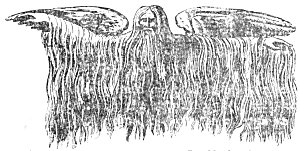The world, according to the philosophers of antiquity, was not a purely material and mechanical machine. A great Soul, diffused everywhere, vivified all the members of the immense body of the Universe; and an Intelligence, equally great, directed all its movements,
p. 415
and maintained the eternal harmony that resulted therefrom. Thus the Unity of the Universe, represented by the symbolic egg, contained in itself two units, the Soul and the Intelligence, which pervaded all its parts: and they were to the Universe, considered as an animated and intelligent being, what intelligence and the soul of life are to the individuality of man.
The doctrine of the Unity of God, in this sense, was taught by Orpheus. Of this his hymn or palinode is a proof; fragments of which are quoted by many of the Fathers, as Justin, Tatian, Clemens of Alexandria, Cyril, and Theodoret, and the whole by Eusebius, quoting from Aristobulus. The doctrine of the LOGOS (word) or the NOOS (intellect), his incarnation, death, resurrection or transfiguration; of his union with matter, his division in the visible world, which he pervades, his return to the original Unity, and the whole theory relative to the origin of the soul and its destiny, were taught in the Mysteries, of which they were the great object.
The Emperor Julian explains the Mysteries of Atys and Cybele by the same metaphysical principles, respecting the demiurgical Intelligence, its descent into matter, and its return to its origin: and extends this explanation to those of Ceres. And so likewise does Sallust the Philosopher, who admits in God a secondary intelligent Force, which descends into the generative matter to organize it. These mystical ideas naturally formed a part of the sacred doctrine and of the ceremonies of initiation, the object of which, Sallust remarks, was to unite man with the World and the Deity; and the final term of perfection whereof was, according to Clemens, the contemplation of nature, of real beings, and of causes. The definition of Sallust is correct. The Mysteries were practised as a means of perfecting the soul, of making it to know its own dignity, of reminding it of its noble origin and immortality, and consequently of its relations with the Universe and the Deity.
What was meant by real beings, was invisible beings, genii, the faculties or powers of nature; everything not a part of the visible world, which was called, by way of opposition, apparent existence. The theory of Genii, or Powers of Nature, and its Forces, personified, made part of the Sacred Science of initiation, and of that religious spectacle of different beings exhibited in the Sanctuary. It resulted from that belief in the providence and superintendence of the Gods, which was one of the primary bases of initiation. The
p. 416
administration of the Universe by Subaltern Genii, to whom it is confided, and by whom good and evil are dispensed in the world, was a consequence of this dogma, taught in the Mysteries of Mithras, where was shown that famous egg, shared between Ormuzd and Ahriman, each of whom commissioned twenty-four Genii to dispense the good and evil found therein; they being under twelve Superior Gods, six on the side of Light and Good, and six on that of Darkness and Evil.
This doctrine of the Genii, depositaries of the Universal Providence, was intimately connected with the Ancient Mysteries, and adopted in the sacrifices and initiations both of Greeks and Barbarians. Plutarch says that the Gods, by means of Genii, who are intermediates between them and men, draw near to mortals in the ceremonies of initiation, at which the Gods charge them to assist, and to distribute punishment and blessing. Thus not the Deity, but His ministers, or a Principle and Power of Evil, were deemed the authors of vice and sin and suffering: and thus the Genii or angels differed in character like men, some being good and some evil; some Celestial Gods, Archangels, Angels, and some Infernal Gods, Demons and fallen Angels.
At the head of the latter was their Chief, Typhon, Ahriman, or Shaitan, the Evil Principle; who, having wrought disorder in nature, brought troubles on men by land and sea, and caused the greatest ills, is at last punished for his crimes. It was these events and incidents, says Plutarch, which Isis desired to represent in the ceremonial of the Mysteries, established by her in memory of her sorrows and wanderings, whereof she exhibited an image and representation in her Sanctuaries, where also were afforded encouragements to piety and consolation in misfortune. The dogma of a Providence, he says, administering the Universe by means of intermediary Powers, who maintain the connection of man with the Divinity, was consecrated in the Mysteries of the Egyptians, Phrygians, and Thracians, of the Magi and the Disciples of Zoroaster; as is plain by their initiations, in which mournful and funereal ceremonies mingled. It was an essential part of the lessons given the Initiates, to teach them the relations of their own souls with Universal Nature, the greatest lessons of all, meant to dignify man in his own eyes, and teach him his place in the Universe of things.

Moe is the founder of GnosticWarrior.com. He is a father, husband, author, martial arts black belt, and an expert in Gnosticism, the occult, and esotericism.





